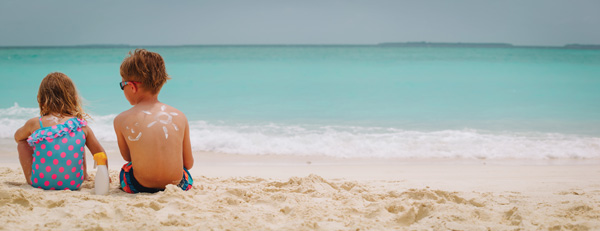
I can’t get sun damage on a cloudy summer day.
Even if you can’t see any blue sky, a significant amount of UV rays can still get through the clouds, so it’s best to apply sunscreen if you’re out and about during the summer.
I can’t get sunburnt in the UK; the UV rays aren’t strong enough.
Wrong! Always protect your skin. Even in the UK.
My sunscreen says it’s water resistant, so I don’t need to reapply regularly.
Despite what the packaging promises, swimming, sweating, rubbing, or towelling down means you will end up removing the sunscreen from your body. Always reapply after sporting activity or at least every two hours.
My skin is only damaged if it turns red.
Sunburn and skin peeling is the extreme end of skin damage from UV rays. When the skin ‘tans’ this is damaging your skin and putting you at risk of skin cancer in the future.
I can’t get sunburnt through windows.
Wrong! UVA radiation can penetrate glass. This can be a car window, or even your windows at home. Be sure to protect your skin if you’re on long car journeys or spend a lot of time sat by sunny windows.
SPF25 is half the SPF protection of SPF50.
SPF50 does not offer twice the protection of SPF25 even though it offers a higher level of protection, so don’t be fooled!
Common missed spots for sunscreen:
Eyelids
The sun’s rays can damage the eyes and surrounding skin over time. The skin of the upper and lower eyelids is thin and fragile, requiring protection. Eyelid cancers account for about 5-10% of all skin cancers and occur most frequently on the lower eyelid. The best defence against this is to wear sunglasses that offer adequate protection against UVA and UVB which cover as much skin as possible.
Back of knees
The legs are the commonest anatomical site for melanoma in females. It is important to reapply sunscreen regularly to achieve the SPF on the bottle, this is particularly true if you are in and out of the water or sweating excessively.
Ears
The ears are a high-risk area, particularly for non-melanoma skin cancers such as basal cell carcinoma and squamous cell carcinoma. These occur as a result of UV exposure from sunlight. Skin cancer on the ears is more common in men than women.
Tops of feet, sides of face, hands and underarms
The same principles apply for all these areas of the body. Any areas of skin that are exposed to UV sunlight should ideally be protected by sunscreen. This should be broad spectrum, containing UVA and UVB protection, with an SPF of at least 30. Try not to miss any areas and leave your skin vulnerable to sunburn.
Scalp and hair
Skin cancers can develop on the scalp. Men, with reduced or thinning scalp hair may be particularly vulnerable to sun damage in this area and should ideally wear a hat. For women, ensure that sunscreen is applied adequately to the margin of the hairline.
Lips
The lips are often an overlooked site for non-melanoma skin cancer. These most commonly affect men over the age of 50 years with fair skin types. The lower lip tends to get more sunlight than the upper lip and is therefore more likely to be affected by skin cancer. Don’t forget to use a photoprotective lip block or lip balm to block UV rays.
The V (neck and chest)
Dermatologists advise that sunscreens should be applied at least 30 minutes before going outdoors and then regularly reapplied every two hours. One way to avoid missing areas may be to apply sunscreen before getting dressed.
Source: www.britishskinfoundation.org.uk











